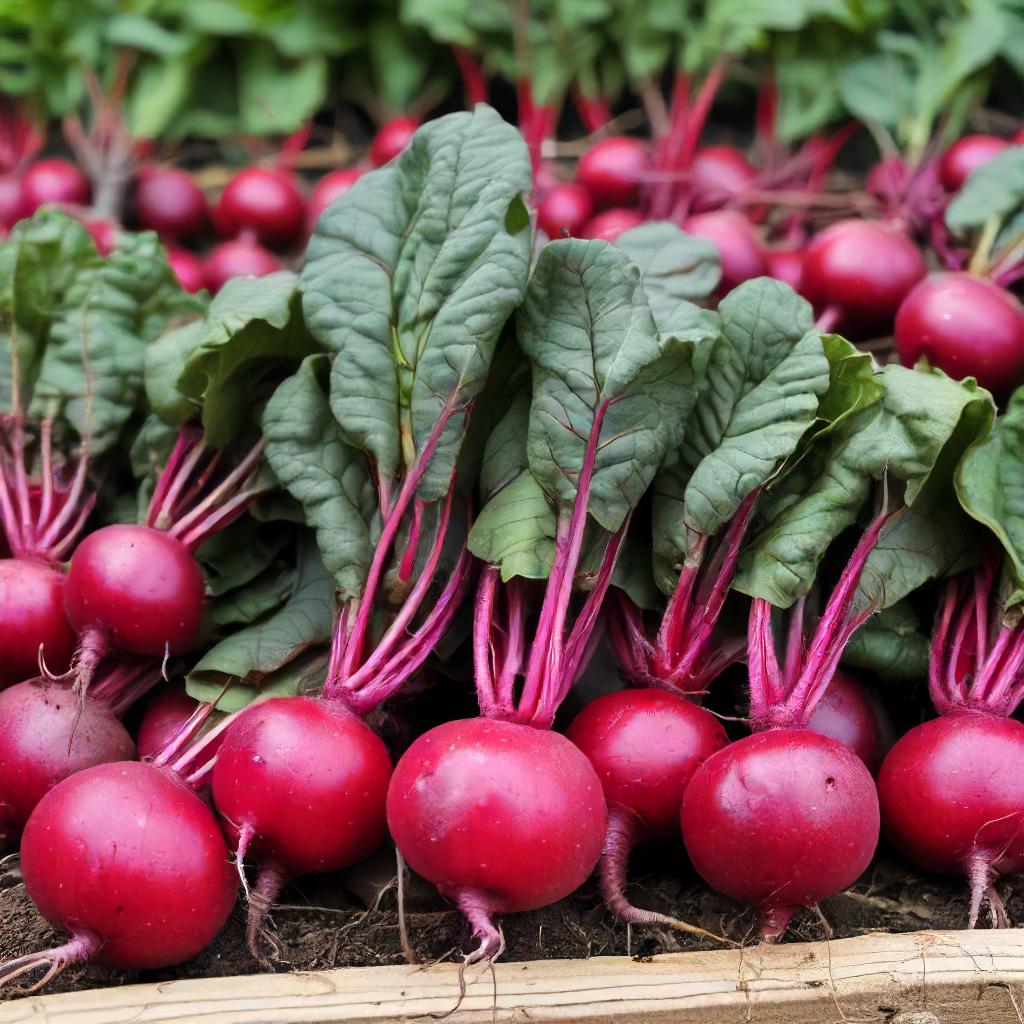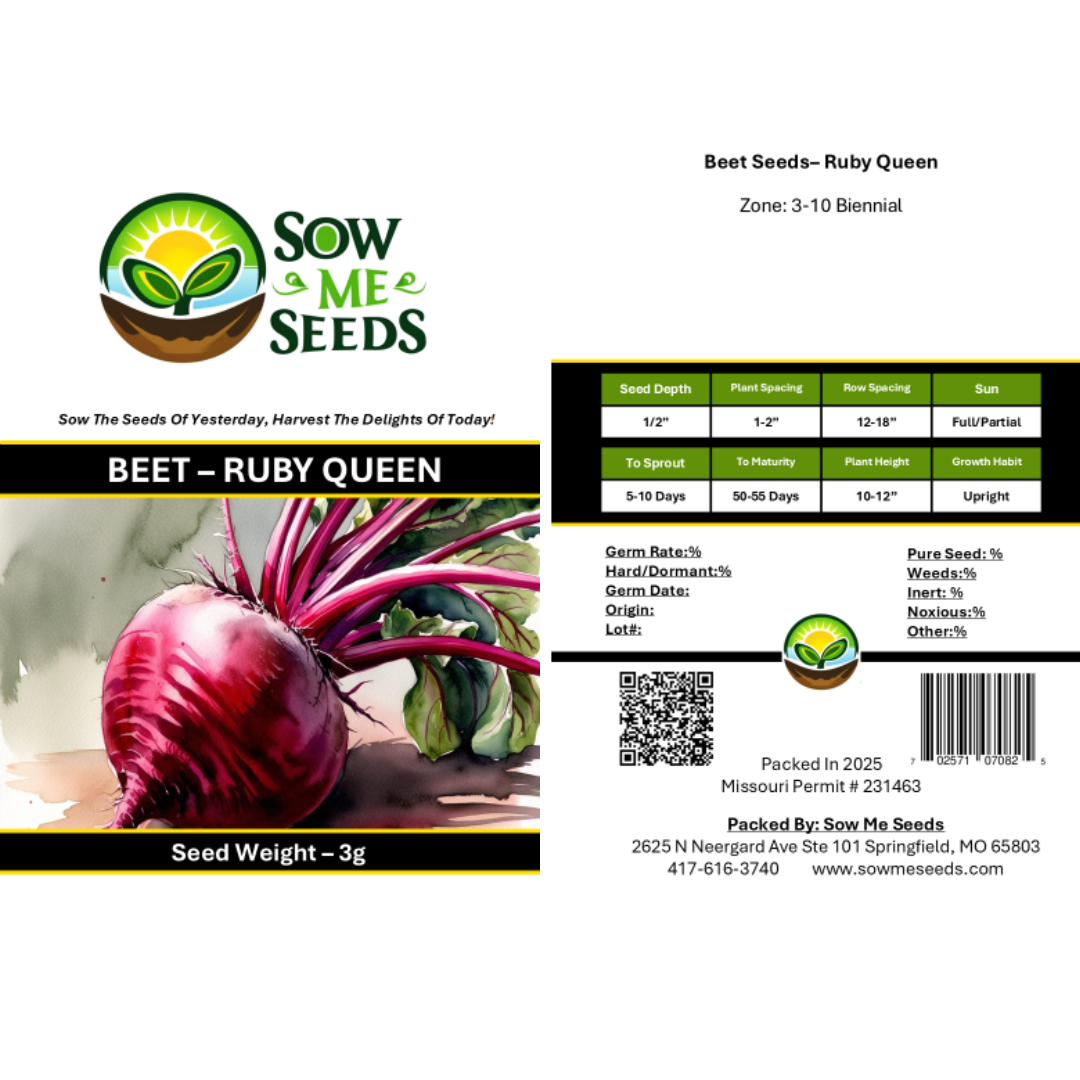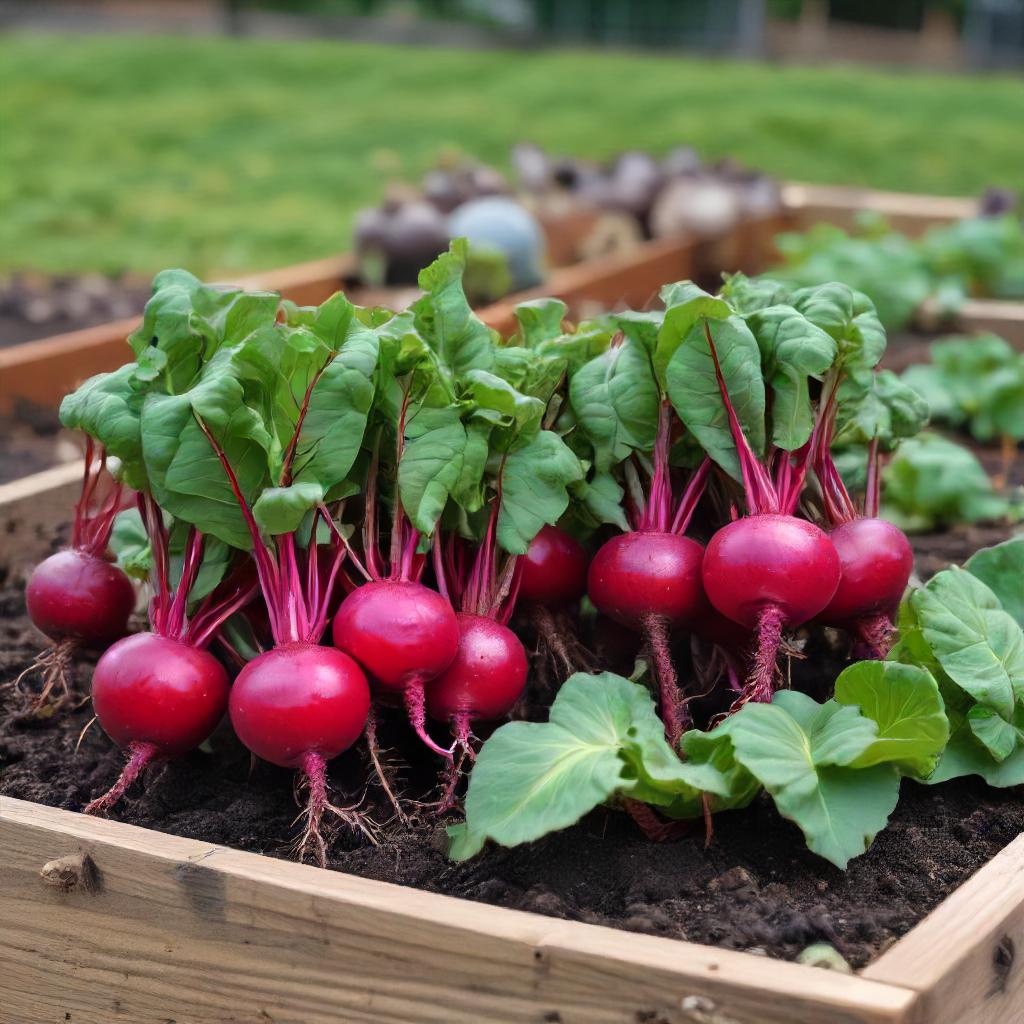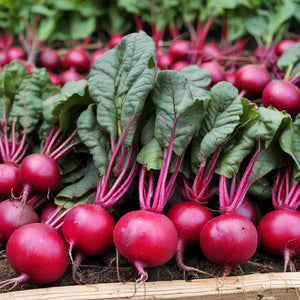- Hardiness Zone: 2-9 Annual
Seed Depth: 1/2 inch
Seed Spacing: 1–2 inches
Row Spacing: 12–18 inches
Sunlight: Full sun to partial shade
Days to Sprout: 5–10 days
Days to Maturity: 50–60 days
Growth Habit: Upright, bushy annual
Sunlight: Thrives in full sun but tolerates partial shade, especially in warmer climates.
Soil Type: Prefers loose, well-drained soil with a pH of 6.0–7.5, free of rocks and debris for uniform root development.
When to Plant: Sow seeds directly outdoors 2–4 weeks before the last frost in spring or 6–8 weeks before the first frost in fall. Beets thrive in cooler temperatures.
Direct Sowing: Plant seeds 1/2 inch deep, spacing them 1–2 inches apart in rows 12–18 inches apart. Thin seedlings to 3–4 inches apart for optimal growth.
Indoor Sowing: Not recommended; direct sowing is preferred for root crops.
Succession Planting: Sow every 2–3 weeks for a continuous harvest during the growing season.
Watering: Water deeply and consistently, keeping the soil evenly moist but not soggy. Inconsistent watering can lead to tough roots.
Fertilizing: Apply a balanced fertilizer or compost at planting to encourage healthy roots and greens. Avoid excessive nitrogen, which promotes leafy growth over roots.
Pruning: No pruning necessary; greens can be harvested sparingly without affecting root development.
Pest and Disease Control: Monitor for leaf miners and aphids. Use row covers and organic treatments as needed.
When to Harvest: Harvest roots when they are 2–3 inches in diameter for the best flavor and texture, typically 50–60 days after planting. Greens can be harvested earlier.
How to Harvest: Loosen soil around the roots with a garden fork and gently pull beets from the ground. Handle with care to avoid bruising.
Seed Collection: Allow some plants to bolt and flower. Collect seeds from dry seed pods.
Storing Seeds: Store seeds in an airtight container in a cool, dry place.
Why You’ll Love It
Deep Color: Produces beautiful dark red roots with consistent interior color — no zoning or streaks.
Sweet and Tender: Mild flavor with smooth texture, even when grown to full size.
Quick and Easy: Grows well in most soils and matures quickly — great for beginners and succession planting.
Dual-Purpose Crop: Edible beet greens can be harvested young for salads or cooked like spinach.
Plant Characteristics
Height: 8–12 inches
Growth Habit: Rosette of leafy greens with round, underground roots
Root Type: Globe-shaped beets, dark red skin and interior
Days to Maturity: 55–60 days
Hardiness: Cool-season biennial grown as an annual
Flavor and Culinary Uses
Flavor: Sweet, earthy, and mellow — excellent fresh or cooked
Culinary Uses: Perfect for roasting, boiling, pickling, shredding raw into salads, or juicing
Companion Planting Tips
Good Companions: Lettuce, onions, bush beans, and kohlrabi
Avoid Planting Near: Pole beans (can stunt beet growth)
Bonus Benefit: The deep taproot helps break up compact soil while the leafy tops feed pollinators when left to bloom
Common Issues and Solutions
Forked Roots: Thin seedlings early and grow in loose, well-drained soil to encourage smooth development
Yellowing Leaves: May indicate a nitrogen deficiency — side-dress with compost or balanced fertilizer
Poor Germination: Soak seeds overnight before planting and keep soil moist during sprouting
Seeds Per Packet
| 3g | Approximately 126 |
| 10g | Approximately 420 |
Why You’ll Love It
Deep Color: Produces beautiful dark red roots with consistent interior color — no zoning or streaks.
Sweet and Tender: Mild flavor with smooth texture, even when grown to full size.
Quick and Easy: Grows well in most soils and matures quickly — great for beginners and succession planting.
Dual-Purpose Crop: Edible beet greens can be harvested young for salads or cooked like spinach.
Plant Characteristics
Height: 8–12 inches
Growth Habit: Rosette of leafy greens with round, underground roots
Root Type: Globe-shaped beets, dark red skin and interior
Days to Maturity: 55–60 days
Hardiness: Cool-season biennial grown as an annual
Flavor and Culinary Uses
Flavor: Sweet, earthy, and mellow — excellent fresh or cooked
Culinary Uses: Perfect for roasting, boiling, pickling, shredding raw into salads, or juicing
Companion Planting Tips
Good Companions: Lettuce, onions, bush beans, and kohlrabi
Avoid Planting Near: Pole beans (can stunt beet growth)
Bonus Benefit: The deep taproot helps break up compact soil while the leafy tops feed pollinators when left to bloom
Common Issues and Solutions
Forked Roots: Thin seedlings early and grow in loose, well-drained soil to encourage smooth development
Yellowing Leaves: May indicate a nitrogen deficiency — side-dress with compost or balanced fertilizer
Poor Germination: Soak seeds overnight before planting and keep soil moist during sprouting
Seeds Per Packet
| 3g | Approximately 126 |
| 10g | Approximately 420 |





Share and get 15% off!
Simply share this product on one of the following social networks and you will unlock 15% off!